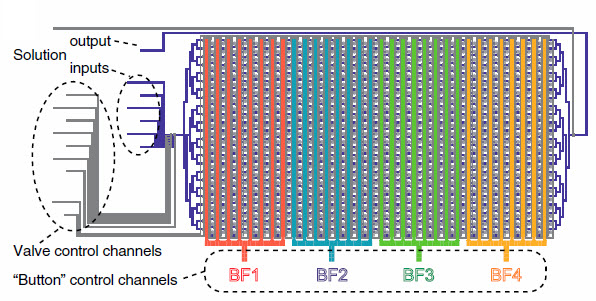Hundreds of biochemical analyses on a single device
September 26, 2012

Design drawing of the k-MITOMI microfluidic device. Blue and grey lines represent flow and control channels, The four separately addressable “button” control channels (BF1 to BF4) are highlighted in red, cyan, green, and yellow. (Credit: Marcel Geertza/PNAS)
Scientists at EPFL and the University of Geneva have developed a microfluidic device smaller than a domino that can simultaneously measure up to 768 biomolecular interactions.
Inside our cells, molecules are constantly binding and separating from one another. It’s this game of constant flux that drives gene expression asides essentially every other biological process.
Understanding the specific details of how these interactions take place is thus crucial to our overall understanding of the fundamental mechanisms of living organisms. There are millions of possible combinations of molecules, however; determining all of them would be a Herculean task.
Various tools have been developed to measure the degree of affinity between a strand of DNA and its transcription factor. They provide an indication of the strength of the affinity between them.
Commercial devices, however, have one main drawback: many preliminary manipulations are necessary before an experiment can be carried out, and even then, the experiment can only focus on a dozen interactions at a time.
Microns-wide channels
As part of his doctoral research at the California Institute of Technology (Caltech), Sebastian Maerkl designed a device that he named “MITOMI” — a small device containing hundreds of microfluidic channels equipped with pneumatic valves. This wee,k Maerkl, who is now an assistant professor in EPFL’s Bioengineering Institute, is publishing an open access article describing the next step in the evolution of the device in Proceedings of the National Academy of Sciences (PNAS). The new version, “k-MITOMI,” was developed in the context of the SystemsX.ch RTD DynamiX in cooperation with the University of Geneva.
This microfluidic device has 768 chambers, each one with a valve that allows DNA and transcription factors to interact in a very carefully controlled manner. “In traditional methods, we generally manage to determine if an interaction takes place or not, and then we restart the experiment with another gene or another transcription factor,” Maerkl explains. “Our device goes much further, because it allows us to measure the affinity and kinetics of the interaction.”
The strength of the device lies in a sort of “push-button” in its microreactors. A protein substrate is immobilized on the device; above it circulates a solution containing DNA moelcules. The push-button is activated at regular intervals of a few milliseconds, trapping protein-DNA complexes that form on the surface of the device. “Then we close the lid, and fluorescence reveals the exact number of bound molecules,” explains Maerkl. “We can also observe how long these molecules remain bound.”
In addition to providing quantitative kinetic information, the k-MITOMI device can work in a “massively parallel” manner. Each of the 768 independent chambers can simultaneously analyze different molecule pairs. It can also be used to synthesize proteins in vitro, with a massive reduction in time and number of manipulations compared to the traditional method, which involves producing proteins inside a living organism such as a bacterium, purifying, and putting them in contact with the genes to be studied.
“The number of protein-protein and protein-DNA interactions that remain to be characterized is phenomenal. Our device not only allows us to accelerate the acquisition of this information, which is crucial to our understanding of living organisms, but it also meets a need for the production of specific proteins,” adds Maerkl.
This research has been conducted with support of a SystemsX.ch research, technology and development grant (DynamiX). SystemsX.ch is a Swiss initiative with the goal of stimulating research and education in key sectors of Systems Biology. http://www.systemsx.ch